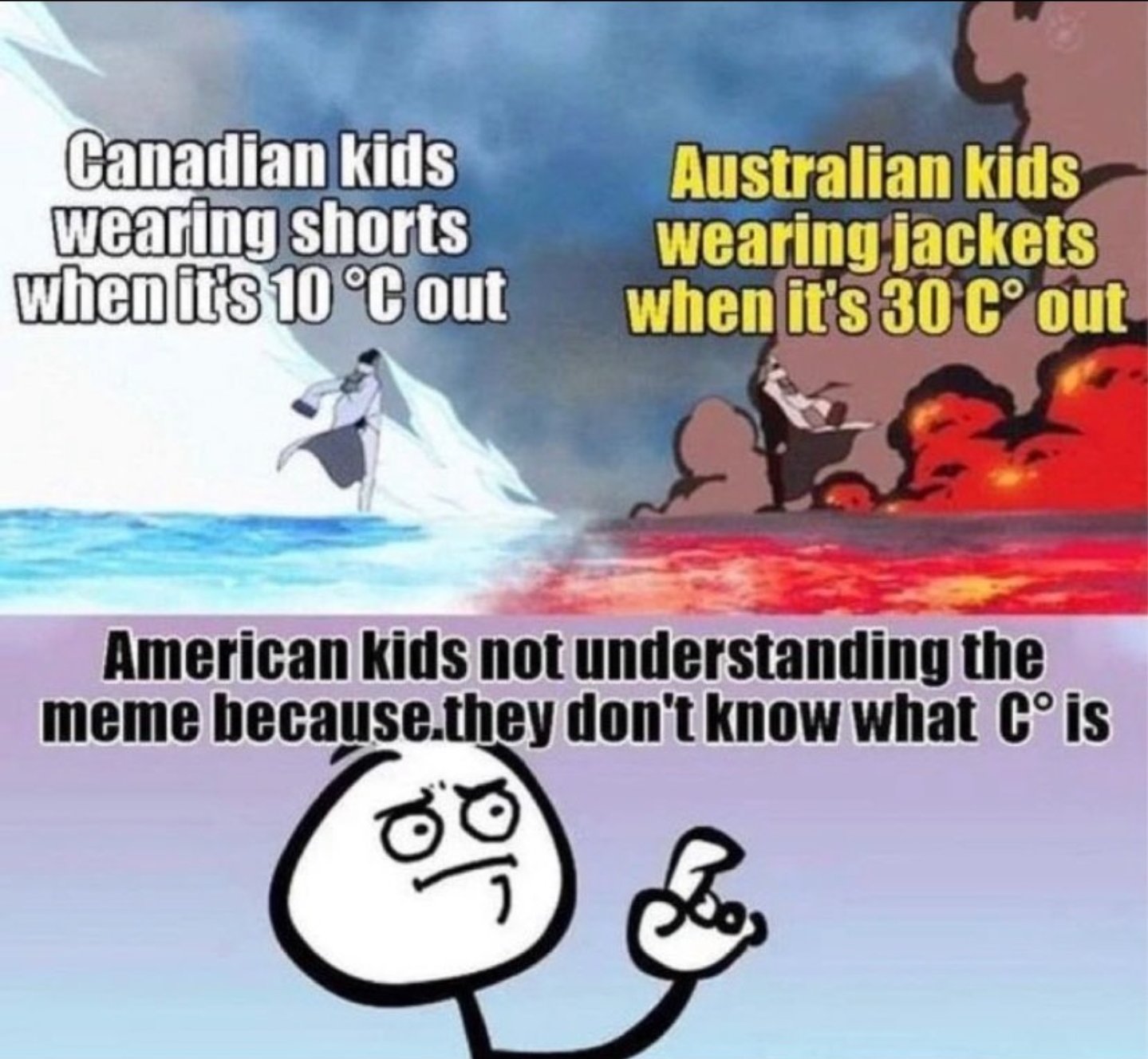this post was submitted on 22 Aug 2023
1950 points (94.1% liked)
Memes
44134 readers
2341 users here now
Rules:
- Be civil and nice.
- Try not to excessively repost, as a rule of thumb, wait at least 2 months to do it if you have to.
founded 5 years ago
MODERATORS
you are viewing a single comment's thread
view the rest of the comments
view the rest of the comments

Let's ignore the fact that celsius is taught in American schools because "hAha AMeRiCa bAd beCauSe nO MeTric."
Then why don't you USE IT?
I personally use metric as much as I can. The temperature on my phone for example is in celsius, try me.
Because for weather, °F is arguably better. 0°F - 100°F is the general range that most weather on the planet happens at (yes I know there are extremes where it gets to like -30°F or 120°F, but bear* with me). You can then further break those up into 10°F segments that are a bit more practical and granular than 10°C segments:
Now I know you can do something similar with °C, but the workable range there is smaller, because you're going from like -15°C to 40°C. It's less granular, and the start/stop temps are more awkward.
Is it weird that water freezes at 32°F and boils at 212°F? Sure, absolutely. When you're doing stuff in that context, it absolutely makes sense to use Celsius, where you're working on a nice, neat 0°C-100°C range. But weather, the thing most people contextualize temperatures with, doesn't happen in that range. It starts well below freezing, and (hopefully) doesn't get anywhere close to the boiling point of water. For that, I'd argue °F is actually a little more useful.
All these arguments don't really have any effect in reality. As someone born in Australia everyone is super comfortable with Celsius and the problems you describe just don't exist because in the end it's really just what you're used to.
To me Fahrenheit seems incredibly awkward but then I wasn't brought up using it.
Oh yeah I absolutely recognize that what you're used to or brought up on is gonna have a huge impact on which system you prefer. That being said, I think a Fahrenheit user would have a harder time switching to Celsius, than a Celsius user would switching to Fahrenheit, at least for normal day-to-day weather applications. And for some of the same reasons that people prefer metric units in general - it's more granular, has more resolution, is base 10 (for this application), etc.
Because it doesn't have as much resolution as Fahrenheit.
There are 180 degrees between freezing water and boiling water in °F. But 100 degrees between the two in °C. So with Fahrenheit we can give mote accurate temperature info without resorting to decimal degrees. And if your response is "learn to handle decimals" then the same argument can be given for inches vs mm.
It’s taught but not really for weather. So while I know the boiling and freezing points of various substances in Celsius, I don’t have instant recognition when I hear a Celsius temperature, I have to convert it in my head.
No need to convert. 0 to 40 is the part of the scale for weather, where 0 is dangerously cold and 40 is dangerously hot.
No need to convert? What do you mean? Are you saying if I just intrinsically knew Celsius for weather I wouldn’t have to convert Celsius? Because that’s obviously true, but I’m just explaining I don’t intrinsically know Celsius in that way.
Also, even if I did get to know Celsius really well, I would still have to convert it every time someone uses Fahrenheit, which is pretty much all the time in the US.
Lastly, what do you mean, saying 0 C is “dangerously cold” and suggesting that below that temp is outside of the bounds of what is used for weather? Where I live the temperature stays below 0 C for long periods of time, never going above it.
If you know those two numbers, 0 and 40, you can get a general idea of what the temperature is in Celsius without doing any math. If you hear 20, you know that's a moderate temperature because it's right in between. If you hear 30, you know that's fairly warm. If you hear 10, you know that's chilly but not freezing. Below 0 or above 40 are extreme cold and extreme heat, respectively.
What's 28° C? How can I envision in my mind what that means?
0-40 as a scale. 28 is about 3/4 between the two. So it's towards the hotter side but how far into it?
It's 82.4° F
Low 80s. I know exactly how low 80's feel.
0-100 is easy to compare with %
82.4° F is 82% hot.
Humans like it around 75% hot between 50-100.
So 82° is hot but not pushing 90s
You can get a general idea of temperature very easy.
40 ain't dangerously hot. Temperature reaches 50°C in some parts of the world.
35°C with 100% humidity can be fatal to humans
46°C with 50% humidity can be fatal to humans
Humans can not survive for extended lengths at these temperatures and humidities.
Saying "40 ain't dangerously hot" is dumb.
It can reach almost 50C right here in the US, even.
56.7° C is the hottest temperature ever recorded. It was in the US.